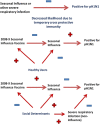The potential effect of temporary immunity as a result of bias associated with healthy users and social determinants on observations of influenza vaccine effectiveness; could unmeasured confounding explain observed links between seasonal influenza vaccine and pandemic H1N1 infection?
- PMID: 22716096
- PMCID: PMC3490826
- DOI: 10.1186/1471-2458-12-458
The potential effect of temporary immunity as a result of bias associated with healthy users and social determinants on observations of influenza vaccine effectiveness; could unmeasured confounding explain observed links between seasonal influenza vaccine and pandemic H1N1 infection?
Abstract
Background: Five observational studies from Canada found an association between seasonal influenza vaccine receipt and increased risk of pandemic influenza H1N1 2009 infection. This association remains unexplained. Although uncontrolled confounding has been suggested as a possible explanation, the nature of such confounding has not been identified. Observational studies of influenza vaccination can be affected by confounding due to healthy users and the influence of social determinants on health. The purpose of this study was to investigate the influence that these two potential confounders may have in combination with temporary immunity, using stratified tables. The hypothesis is that respiratory virus infections may activate a temporary immunity that provides short-term non-specific protection against influenza and that the relationship with being a healthy user or having a social determinant may result in confounding.
Methods: We simulated the effect of confounding on vaccine effectiveness assuming that this could result from both social determinants and healthy user effects as they both influence the risk of seasonal influenza and non-influenza respiratory virus infections as well as the likelihood of being vaccinated. We then examined what impact this may have had on measurement of seasonal influenza vaccine effectiveness against pandemic influenza.
Results: In this simulation, failure to adjust for healthy users and social determinants would result in an erroneously increased risk of pandemic influenza infection associated with seasonal influenza vaccination. The effect sizes were not however large.
Conclusions: We found that unmeasured healthy user effects and social determinants could result in an apparent association between seasonal influenza vaccine and pandemic influenza infection by virtue of being related to temporary immunity. Adjustment for social determinants of health and the healthy user effects are required in order to improve the quality of observational studies of influenza vaccine effectiveness.
Figures


Similar articles
-
Seasonal influenza vaccination and the risk of infection with pandemic influenza: a possible illustration of non-specific temporary immunity following infection.Euro Surveill. 2010 Nov 25;15(47):19722. doi: 10.2807/ese.15.47.19722-en. Euro Surveill. 2010. PMID: 21144441
-
Modelling the effect of seasonal influenza vaccination on the risk of pandemic influenza infection.BMC Public Health. 2011 Feb 25;11 Suppl 1(Suppl 1):S11. doi: 10.1186/1471-2458-11-S1-S11. BMC Public Health. 2011. PMID: 21356130 Free PMC article.
-
Further evidence for bias in observational studies of influenza vaccine effectiveness: the 2009 influenza A(H1N1) pandemic.Am J Epidemiol. 2013 Oct 15;178(8):1327-36. doi: 10.1093/aje/kwt124. Epub 2013 Aug 26. Am J Epidemiol. 2013. PMID: 23978527 Free PMC article.
-
Narcolepsy, 2009 A(H1N1) pandemic influenza, and pandemic influenza vaccinations: what is known and unknown about the neurological disorder, the role for autoimmunity, and vaccine adjuvants.J Autoimmun. 2014 May;50:1-11. doi: 10.1016/j.jaut.2014.01.033. Epub 2014 Feb 19. J Autoimmun. 2014. PMID: 24559657 Review.
-
Pandemic influenza H1N1 2009, innate immunity, and the impact of immunosenescence on influenza vaccine.Yale J Biol Med. 2009 Dec;82(4):143-51. Yale J Biol Med. 2009. PMID: 20027279 Free PMC article. Review.
Cited by
-
Non-neutralizing antibodies induced by seasonal influenza vaccine prevent, not exacerbate A(H1N1)pdm09 disease.Sci Rep. 2016 Nov 16;6:37341. doi: 10.1038/srep37341. Sci Rep. 2016. PMID: 27849030 Free PMC article.
-
Vaccine effectiveness against laboratory-confirmed influenza hospitalizations among elderly adults during the 2010-2011 season.Clin Infect Dis. 2013 Sep;57(6):820-7. doi: 10.1093/cid/cit404. Epub 2013 Jun 20. Clin Infect Dis. 2013. PMID: 23788243 Free PMC article.
-
Surveillance and vaccine effectiveness of an influenza epidemic predominated by vaccine-mismatched influenza B/Yamagata-lineage viruses in Taiwan, 2011-12 season.PLoS One. 2013;8(3):e58222. doi: 10.1371/journal.pone.0058222. Epub 2013 Mar 5. PLoS One. 2013. PMID: 23472161 Free PMC article.
-
Partial protection against 2009 pandemic influenza A (H1N1) of seasonal influenza vaccination and related regional factors: Updated systematic review and meta-analyses.Hum Vaccin Immunother. 2015;11(6):1337-44. doi: 10.4161/21645515.2014.985495. Hum Vaccin Immunother. 2015. PMID: 25692308 Free PMC article.
References
-
- Skowronski DM, De Serres G, Crowcroft NS, Janjua NZ, Boulianne N, Hottes TS. et al.Association between the 2008-09 seasonal influenza vaccine and pandemic H1N1 illness during Spring-Summer 2009: four observational studies from Canada. PLoS Med. 2010;7(4):e1000258. doi: 10.1371/journal.pmed.1000258. - DOI - PMC - PubMed
-
- Rosella LC, Groenwold RHH, Crowcroft NS. Assessing the impact of confounding (measured and unmeasured) in a case control study to examine the increased risk of pandemic A/H1N1 associated with receipt of the 2008-9 seasonal influenza vaccine. Vaccine. - PubMed
MeSH terms
Substances
LinkOut - more resources
Full Text Sources
Medical

